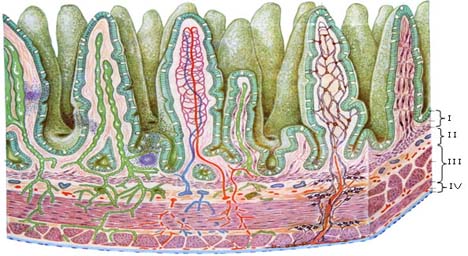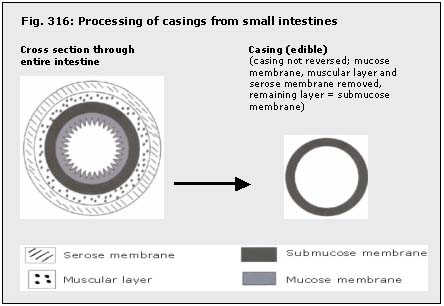It has come to my attention in recent months that there are some rumors making the rounds about our beef gut supplier. I have received conflicting stories, but the gist seems to be that the workshop in Ireland that supplies us with material mishandles the gut by not removing the musose layer from the casing, which results in introducing non-muscle fibers into the strings, weakening them.
In defense of our supplier, and to reassure our customers that there is no problem with our strings, I thought I would explain a little about how the anatomy of the cow intestine works so that I can demonstrate how this rumor is not accurate to the quality of material and strings.
Below is an illustration of the four layers in the wall of the bovine intestine.

From Inside:
I - Mucose membrane with finger-like outgrowths for enlarged surface area (“slime”)
II - Submucose membrane, firm-elastic layer mainly of connective tissue
III - Muscular layer, the circular internal one, the outside one longitudinal
IV - Serose membrane (blue) thin coating covering the abdominal cavity from inside and surrounding all organs
____________________________________________________________________
In cross-section, the layers are represented in the diagram below:

In processing the bovine casing for string production, the intestine is split lengthwise into ribbons. The ribbons can vary in width according to the needs of the string and when we order from the supplier, we order the ribbons, or threads, by width and the width needed is determined by the diameter of string we intend to make, the wider threads going into thicker strings and the more narrow threads going into smaller diameters.
As the gut comes off of the splitting machine one of the workers separates the mucose and submucose layers from the muscular and serose layers, as can be seen in the video below from the Gamut YouTube channel:
The muscular and serosa layers are very tightly bound together. It is difficult, but possible, to separate these layers and it is my understanding that some makers in the past have done this prior to twisting the strings. However, we here at Gamut Music are dictated to reproducing historical strings and no less an authority of strings making than Marin Mersenne was quite clear about which layers of the intestine should be used in string making when he made the comment about the habits of string makers:
“But they soak them (casings) a day before winding them upon their pegs, so as to clean them and to draw off the fat and all that is superfluous, and so as to leave the membrane alone, of three sorts of fibers, that is, the straight, the transverse, and the oblique, from which it takes its strength, …)
It is the three layers described in the illustrations that correspond to the three layers that Mersanne specifies as being critical to the strength of a string.
In short, the rumors criticizing our supplier are completely unfounded and are circulated, I suspect, by people that do not fully understand the process of making strings.
Please be assured that we and our suppliers are diligent to continue the tradition of making quality strings in the traditional way. When something goes wrong with a string, perhaps the material has something to do with it, but most probably, it is the string maker that has done something wrong. As we say in the workshop, “strings happen.”
These pictures come from the FAO Corporate Document Repository, produced by the Regional Office for Asia and the Pacific, www.fao.org.
This diagram also comes from the FAO Corporate Document Repository, produced by the Regional Office for Asia and the Pacific, www.fao.org.
Marin Mersenne, Harmonie Universelle: The Book On Instruments, translated by Roger E. Chapman, Martinus Nijhoff / The Hague, 1957, page 17.
